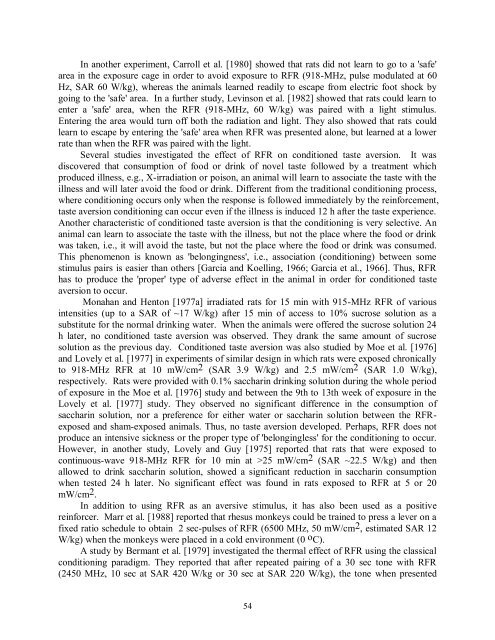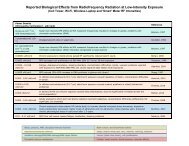Evidence for Effects on Neurology and Behavior - BioInitiative Report
Evidence for Effects on Neurology and Behavior - BioInitiative Report
Evidence for Effects on Neurology and Behavior - BioInitiative Report
Create successful ePaper yourself
Turn your PDF publications into a flip-book with our unique Google optimized e-Paper software.
In another experiment, Carroll et al. [1980] showed that rats did not learn to go to a 'safe'<br />
area in the exposure cage in order to avoid exposure to RFR (918-MHz, pulse modulated at 60<br />
Hz, SAR 60 W/kg), whereas the animals learned readily to escape from electric foot shock by<br />
going to the 'safe' area. In a further study, Levins<strong>on</strong> et al. [1982] showed that rats could learn to<br />
enter a 'safe' area, when the RFR (918-MHz, 60 W/kg) was paired with a light stimulus.<br />
Entering the area would turn off both the radiati<strong>on</strong> <strong>and</strong> light. They also showed that rats could<br />
learn to escape by entering the 'safe' area when RFR was presented al<strong>on</strong>e, but learned at a lower<br />
rate than when the RFR was paired with the light.<br />
Several studies investigated the effect of RFR <strong>on</strong> c<strong>on</strong>diti<strong>on</strong>ed taste aversi<strong>on</strong>. It was<br />
discovered that c<strong>on</strong>sumpti<strong>on</strong> of food or drink of novel taste followed by a treatment which<br />
produced illness, e.g., X-irradiati<strong>on</strong> or pois<strong>on</strong>, an animal will learn to associate the taste with the<br />
illness <strong>and</strong> will later avoid the food or drink. Different from the traditi<strong>on</strong>al c<strong>on</strong>diti<strong>on</strong>ing process,<br />
where c<strong>on</strong>diti<strong>on</strong>ing occurs <strong>on</strong>ly when the resp<strong>on</strong>se is followed immediately by the rein<str<strong>on</strong>g>for</str<strong>on</strong>g>cement,<br />
taste aversi<strong>on</strong> c<strong>on</strong>diti<strong>on</strong>ing can occur even if the illness is induced 12 h after the taste experience.<br />
Another characteristic of c<strong>on</strong>diti<strong>on</strong>ed taste aversi<strong>on</strong> is that the c<strong>on</strong>diti<strong>on</strong>ing is very selective. An<br />
animal can learn to associate the taste with the illness, but not the place where the food or drink<br />
was taken, i.e., it will avoid the taste, but not the place where the food or drink was c<strong>on</strong>sumed.<br />
This phenomen<strong>on</strong> is known as 'bel<strong>on</strong>gingness', i.e., associati<strong>on</strong> (c<strong>on</strong>diti<strong>on</strong>ing) between some<br />
stimulus pairs is easier than others [Garcia <strong>and</strong> Koelling, 1966; Garcia et al., 1966]. Thus, RFR<br />
has to produce the 'proper' type of adverse effect in the animal in order <str<strong>on</strong>g>for</str<strong>on</strong>g> c<strong>on</strong>diti<strong>on</strong>ed taste<br />
aversi<strong>on</strong> to occur.<br />
M<strong>on</strong>ahan <strong>and</strong> Hent<strong>on</strong> [1977a] irradiated rats <str<strong>on</strong>g>for</str<strong>on</strong>g> 15 min with 915-MHz RFR of various<br />
intensities (up to a SAR of ~17 W/kg) after 15 min of access to 10% sucrose soluti<strong>on</strong> as a<br />
substitute <str<strong>on</strong>g>for</str<strong>on</strong>g> the normal drinking water. When the animals were offered the sucrose soluti<strong>on</strong> 24<br />
h later, no c<strong>on</strong>diti<strong>on</strong>ed taste aversi<strong>on</strong> was observed. They drank the same amount of sucrose<br />
soluti<strong>on</strong> as the previous day. C<strong>on</strong>diti<strong>on</strong>ed taste aversi<strong>on</strong> was also studied by Moe et al. [1976]<br />
<strong>and</strong> Lovely et al. [1977] in experiments of similar design in which rats were exposed chr<strong>on</strong>ically<br />
to 918-MHz RFR at 10 mW/cm 2 (SAR 3.9 W/kg) <strong>and</strong> 2.5 mW/cm 2 (SAR 1.0 W/kg),<br />
respectively. Rats were provided with 0.1% saccharin drinking soluti<strong>on</strong> during the whole period<br />
of exposure in the Moe et al. [1976] study <strong>and</strong> between the 9th to 13th week of exposure in the<br />
Lovely et al. [1977] study. They observed no significant difference in the c<strong>on</strong>sumpti<strong>on</strong> of<br />
saccharin soluti<strong>on</strong>, nor a preference <str<strong>on</strong>g>for</str<strong>on</strong>g> either water or saccharin soluti<strong>on</strong> between the RFRexposed<br />
<strong>and</strong> sham-exposed animals. Thus, no taste aversi<strong>on</strong> developed. Perhaps, RFR does not<br />
produce an intensive sickness or the proper type of 'bel<strong>on</strong>gingless' <str<strong>on</strong>g>for</str<strong>on</strong>g> the c<strong>on</strong>diti<strong>on</strong>ing to occur.<br />
However, in another study, Lovely <strong>and</strong> Guy [1975] reported that rats that were exposed to<br />
c<strong>on</strong>tinuous-wave 918-MHz RFR <str<strong>on</strong>g>for</str<strong>on</strong>g> 10 min at >25 mW/cm 2 (SAR ~22.5 W/kg) <strong>and</strong> then<br />
allowed to drink saccharin soluti<strong>on</strong>, showed a significant reducti<strong>on</strong> in saccharin c<strong>on</strong>sumpti<strong>on</strong><br />
when tested 24 h later. No significant effect was found in rats exposed to RFR at 5 or 20<br />
mW/cm 2 .<br />
In additi<strong>on</strong> to using RFR as an aversive stimulus, it has also been used as a positive<br />
rein<str<strong>on</strong>g>for</str<strong>on</strong>g>cer. Marr et al. [1988] reported that rhesus m<strong>on</strong>keys could be trained to press a lever <strong>on</strong> a<br />
fixed ratio schedule to obtain 2 sec-pulses of RFR (6500 MHz, 50 mW/cm 2 , estimated SAR 12<br />
W/kg) when the m<strong>on</strong>keys were placed in a cold envir<strong>on</strong>ment (0 o C).<br />
A study by Bermant et al. [1979] investigated the thermal effect of RFR using the classical<br />
c<strong>on</strong>diti<strong>on</strong>ing paradigm. They reported that after repeated pairing of a 30 sec t<strong>on</strong>e with RFR<br />
(2450 MHz, 10 sec at SAR 420 W/kg or 30 sec at SAR 220 W/kg), the t<strong>on</strong>e when presented<br />
54



